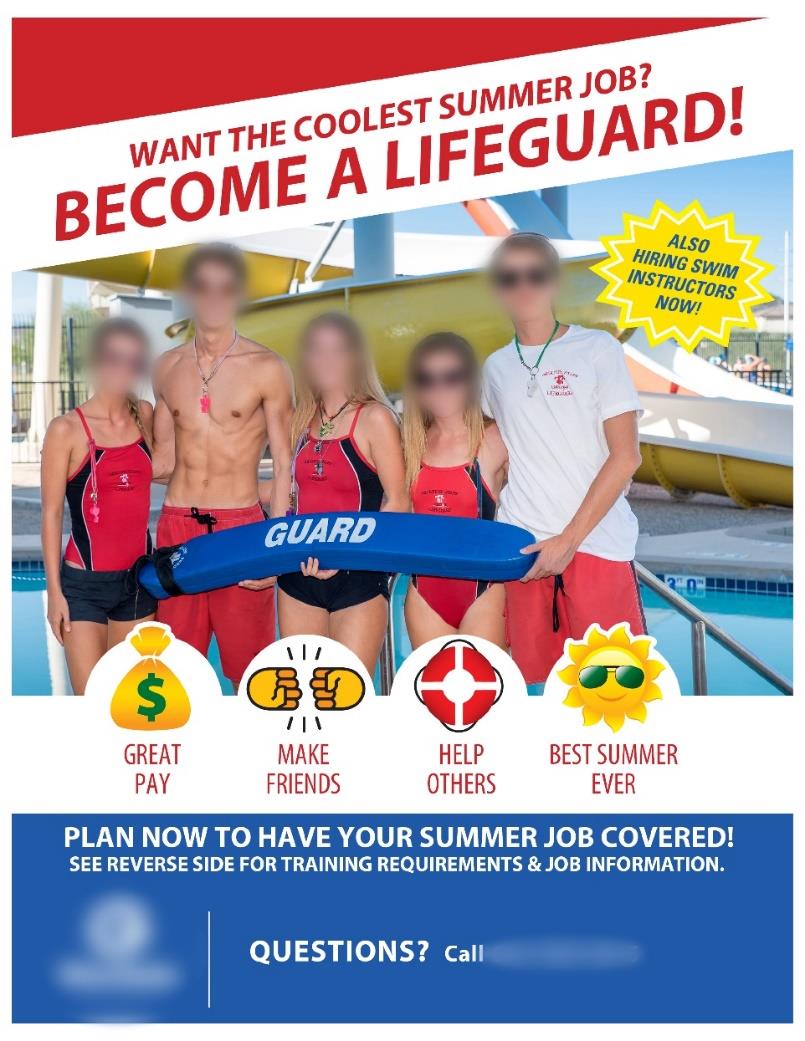By Vicki Rios
Words are powerful and they have meaning, and when it comes to issues of equity, we know the word equity doesn’t mean the same thing as equal, right? Or maybe you’ve heard the saying attributed to Ralph Waldo Emerson, “What you do speaks so loudly, I cannot hear what you say.”
Images are just as powerful, if not more, than words. A New York Times article, titled “Ferguson Images Evoke Civil Rights Era and Changing Visual Perceptions,” discusses the news images published during the protests following the fatal shooting of Michael Brown in 2014. The authors note “the increasingly sophisticated ways an image-saturated public reads a picture’s racial and political subtext; and about the rapid transformation of the protests, even more so than the Los Angeles riots or the Occupy movement, into a war of images.”1
If a picture is truly worth a thousand words, what does this advertisement, Image 1, say about our community as a prospective employer?

Image 1
According to 2020 U.S. census data, the population of my community, Glendale, Arizona, is 75 percent white, 6 percent, black, 1.7 percent Native American, 4.1 percent Asian or Pacific Islander, and 16.95 percent from other races. Forty percent of our city identifies as being from two or more races and approximately 35.5 percent of the population is Hispanic or Latino of any race.
The city operates two pools in two distinct regions of the city. Pool A is in an affluent neighborhood and Pool B is in a working class and predominately Hispanic neighborhood. Both pools were closed for the 2020 season due to the COVID-19 pandemic. As the city prepared to reopen the pools in 2021, it experienced a severe shortage of lifeguards and swimming instructors (collectively referred to as lifeguards). Many lifeguards who had worked the 2019 season had moved on to other jobs and no new lifeguards were in the pipeline to replace them. Determined to hire enough lifeguards to properly staff the pools, the city began running more advertisements and implemented a small $200 incentive to boost the recruitment numbers. The advertisement labeled Image 1 was disseminated and applications began trickling in. This is when the photo in the advertisement first came to my attention.
This article isn’t really about lifeguards or pools. It’s about the power of images and how they convey a message.
In my discussions with our staff here at the city, I came to understand that this photo had been used for the purpose of recruiting lifeguards for many years. And let’s be clear, there is nothing wrong with this photo. It is a beautiful picture of the city’s actual lifeguards, which was taken at Pool A, by the city’s photographer. (The faces have been blurred to protect the innocent). The advertisement reflects the demographics of the lifeguards we had been hiring: 63.77 percent white, 1.45 percent black, 1.45 percent Hawaiian or Pacific Islander, 4.35 percent two or more races, and 18.84 percent Hispanic. In addition, 10.15 percent declined or did not answer.
As I asked more questions regarding the photo, our hiring practices, and the lifeguard shortage, perhaps not surprisingly, I discovered the following barriers to employment:
- The city offered lifeguard training courses for a fee of $250 with no guarantee of employment if the student passed the course.
- Prior recruitment relied heavily on relationships with a few high school swim teams and coaches.
- Job fairs were held only at Pool A.
- Some lifeguards had expressed that they only wanted to work at Pool A.
- The city had a Junior Lifeguard program that had not been used or updated in several years.
Taking Action
As the first of many steps in the right direction, the quick and easy fix was to change out the photo in the advertisement. The city’s photo was replaced with a stock photo as seen in Image 2.

Image 2
Despite its best efforts, the city was only able to open one pool at a time during the 2021 season. Staff were required to work for the entire season, including a month at Pool A and a month at Pool B in order to receive their bonus payment. For the 2022 season, the city took additional steps to boost recruiting:
- Started its recruiting efforts in December 2021, earlier than usual.
- Lowered the price of lifeguard training classes to $125 for residents and $150 for non-residents and offered reimbursement of the fee if you worked for the city for the summer.
- Posted recruitment items on its social media channels.
- Met with and distributed flyers to guidance counselors at 60+ high schools and middle schools across the region, including schools in neighboring communities.
- Revived a free Junior Lifeguard program.
- Held job fairs in two different and diverse areas of the city.
- Sent a citywide email to all employees and councilmembers requesting their help in recruiting lifeguards.
- Matched a neighboring city’s bonus of $2,500 for lifeguards who work the entire season.
These efforts led to better results in 2022, but still left the city about 50 percent shy of the number of lifeguards needed to open both pools for the entire swim season. Pools will once again be open only one at a time for one month at each location. Hiring demographics of lifeguards were very similar: 68 percent white, 2.13 percent black, 1.06 percent Hawaiian or Pacific Islander, 3.19 percent two or more races, 18.09 percent identified as Hispanic, and 7.44 percent declined or did not answer.
Planning for the Future
However, the Junior Lifeguard program is an outstanding success. It will run for the first two weeks at each of the pools and will prepare 20 13-to-15-year-old attendees (10 at each pool) for lifeguarding opportunities in the future. The program covers topics like standards, water safety, swimming techniques, personal safety, heat emergencies, spinal emergencies, recognizing victims, causes of drowning, rescues from water, and Cardiopulmonary Resuscitation (CPR). The 10 participants at each pool will also spend time shadowing the city’s lifeguards and learning about teamwork, customer service, respect, reliability, setting goals, and other valuable life skills.
Outdoor recreation, especially swimming, is very popular in our city. Water safety is also an issue in our region where drowning is the leading cause of death of children ages one to four. Private lessons can be as much as $25 per half-hour, making them clearly unaffordable for even moderate-income families. Alternatively, the city offers four hours of swimming lessons at a cost of $26, making city pools a primary resource for affordable swimming lessons in our community. And the city offers scholarships to low-income families so that its already low-priced lessons can be free to qualifying families. But without lifeguards, the city’s ability to offer any lessons is extremely limited.
The city recently invested over $2.5 million dollars in improvements to both pools. Pool B had several major leaks that required structural repairs and involved filling in voids under the shell of the pool where the soil had fallen away. Failing to adequately staff and maintain the two remaining city pools would mean failing to protect the sizeable investment the city made into the community when it repaired and improved both pools. Several years earlier, during the most recent economic downturn, another city pool in the same general vicinity had similar leaks and the city opted to fill in and abandon that pool. This caused a major outcry from the community and several councilmembers. After 10 years and multiple calls from the community for reconsideration and reconstruction of the pool, the council reached a compromise by funding the construction of a new splash pad at that location, which doesn’t require lifeguards and is much less expensive to operate and maintain.
Taking a Closer Look
One thing is clear: our community cares about splash pads, pools, swimming, and lessons. But putting the DEI lens on advertising has far greater implications for our city. In the fall of 2021, city staff prepared for the cooler weather by sending me a draft of their fall catalog of other recreational opportunities. This was another beautiful document filled with pictures of our community at play but placing the DEI lens on those photos once again created more questions than answers. I made the following observations:
- Photos of our aquatic activities were representative of the diversity in our community.
- Some photos showed adults and children of all sizes and skin tones playing together.
- Still more than 50 percent of the photos showed all fair-skinned people taking part in activities.
- Stock photos were stereotypical, girls practicing ballet, boys practicing martial arts.
- Three light-skinned females in softball uniforms were showcased on the youth sports page, but the photo showed a partial view of a young boy with a dark complexion who was cut out.
The photos were updated before the final version went to print. It was clear to me we were learning, but we weren’t yet where we needed to be in terms of our DEI lens.
Parks and Recreation magazine’s 2022 Aquatics Guide identifies lifeguard and aquatics staff shortages as an international issue.2 The article suggests improved human resources processes, especially in the areas of job analysis, are needed to solve this issue. The city will be implementing end-of-season surveys and interviews of lifeguards this year to help us determine what draws people to and away from the job so that we can recruit in more targeted ways in the future. The study also suggests using “realistic job previews” to show applicants what it really feels like to work as a lifeguard. Our Junior Lifeguard program is a good step in this direction.
Conclusion
But this article isn’t really about lifeguards or pools. It’s about the power of images and how they convey a message. Our community is not unlike many others in that we start with the document and photo we used last year, we change the dates, change the names, and keep going on without “seeing” or giving much thought to the final product.
Consider the power of images and put the “DEI lens” on your advertising, photos, and other materials. Using the DEI lens can add focus, clarity, light, dimension, and a different kind of beauty to our work.
Vicki Rios is assistant city manager of Glendale, Arizona and a recent fellow of the Leadership Institute on Race, Equity, and Inclusion sponsored by The Kettering Foundation, National Civic League and the International City/County Management Association.



